| Starfleet Headquarters in 2151. |
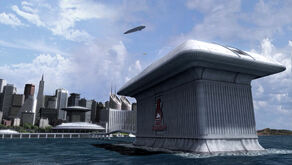 |
| San Francisco Bay Stadium and skyline in 2154. |
 |
| The San Francisco skyline at night in 2150s. |
 |
| San Francisco in 2258 (alternate reality) |
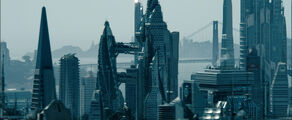 |
| San Francisco in 2259 (alternate reality) |
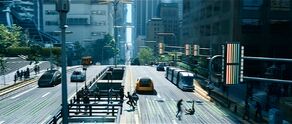 |
| A busy street in San Francisco (2259) |
| The view over San Francisco Bay with the Golden Gate Bridge in the foreground in 2272. |
 |
| Outside the Federation Council Chamber in 2286. |
 |
| Golden Gate bridge at night in 2293. |
| Starfleet Academy campus in 2368. |
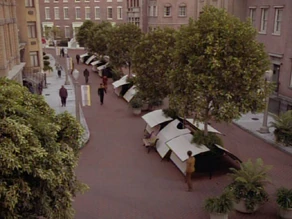 |
| 24th century San Francisco streets. (2372) |
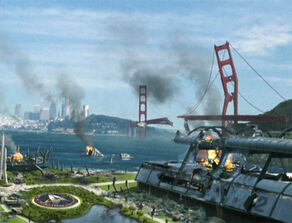 |
| San Francisco in ruins following the Breen attack in 2375. |
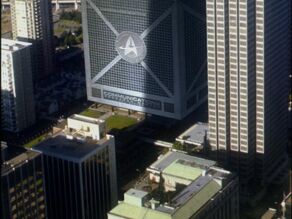 |
| San Francisco Financial District in 2377. |
San Francisco was a city on the North American continent of Earth, named after St. Francis of Assisi, and constituted one of the most important cities throughout both the planet itself and United Federation of Planets as a whole. The Federation was founded in this city, in 2161. Many of the city's older structures, most notably the Golden Gate Bridge, remained intact into the 24th century, indicating it was one of the few large cities to escape destruction during World War III. (TNG: "The Outcast"; Star Trek IV: The Voyage Home; Star Trek: First Contact; ENT: "Zero Hour", "These Are the Voyages...")
Early history
Although founded as a Spanish colony in the 18th century, San Francisco first gained prominence in 1849, after gold was discovered in California. Thousands of American fortune seekers, known as the 49ers, settled in the city.
By 1893, San Francisco had a growing and diverse population, including professional gamblers like Frederick La Rouque and Joe Falling Hawk, as well as aspiring writers such as Jack London. The city also attracted a number of alien visitors, unbeknown to the Human population. Among these included the malevolent Devidians, and the El-Aurian Guinan, who masqueraded as a wealthy local patron.
During this time, occasional health epidemics struck San Francisco particularly hard. Outbreaks of cholera killed many residents. (TNG: "Time's Arrow", "Time's Arrow, Part II")
In an alternative reality of World War II created by Vosk's faction of the Temporal Cold War, Nazi Germany successfully invaded the East Coast of North America, while San Francisco remained under allied control. A squadron of P-51 Mustangs defended the city from air raids in this reality. (ENT: "Storm Front")
In the mid-20th century, San Francisco was the setting for novels featuring the adventures of the iconic private detective Dixon Hill. It also served as the backdrop for many movies, including the comedic classic The Man From San Francisco. (ENT: "Cogenitor"; TNG: "The Big Goodbye")
By the end of that century, however, San Francisco had become a polluted metropolis, with a culture that was described by various commentators as "primitive," "paranoid," and "medieval." The age seemed to have been characterized by greed, lack of proper medical care, and environmental crises, causing Leonard McCoy to consider it a miracle the citizens were able to survive into the 21st century. (Star Trek IV: The Voyage Home)
The city's social ills became even more pronounced by the 2020s. Massive unemployment and homelessness caused unrest in the streets. The government responded by instituting the system of Sanctuary Districts, requiring vagrants to live in segregated ghettos patrolled by law enforcement. Ostensibly, the Sanctuary Districts served only as temporary shelters until jobs could be found. In reality, they became a way to keep the segment of the population deemed "undesirable" out of the public eye.
An economic recovery eventually occurred. This led to the closure of the Sanctuary Districts. (DS9: "Past Tense, Part I", "Past Tense, Part II")
San Francisco benefited enormously from radical changes that came after Earth's First Contact with Vulcans. It soon became home to important United Earth institutions, including the precursor to Starfleet. The skyline was also altered significantly, with a host of new skyscrapers eclipsing both the Transamerica Building and Golden Gate Bridge. (ENT: "Broken Bow"; Star Trek: The Motion Picture; Star Trek)
Role in diplomacy
San Francisco had a prestigious history as a place of peace. In 1945, the Charter for the United Nations was signed in the city by some fifty of Earth's nation-states.
After World War III, the nations of the world met in San Francisco to negotiate a peace treaty. (ENT: "Demons")
The spotlight of diplomacy fell on San Francisco again in 2155, when the representatives of Earth, Vulcan, Tellar, Andoria, Denobula, Rigel V, and Coridan met in the city to hold talks on the formation of a Coalition of Planets. (ENT: "Demons", "Terra Prime")
Six years later, in 2161, the charter that lead to the founding of the United Federation of Planets was signed in San Francisco. (ENT: "Zero Hour", "These Are the Voyages...")
Incidents of time travel
In 2286, Admiral James T. Kirk journeyed back through time to 1986 San Francisco, in a successful effort to retrieve two humpback whales from the Cetacean Institute in the nearby city of Sausalito. (Star Trek IV: The Voyage Home)
In 2368, archaeologists digging beneath the Presidio uncovered several artifacts from the late 19th century. Among several mundane artifacts was the severed head of Lieutenant Commander Data, which had been undisturbed for nearly five hundred years. It was learned that Data and several members of the USS Enterprise-D's crew had traveled back through time to late nineteenth century San Francisco in an effort to prevent the Devidians from draining the neural energy of Humans and disguising it as a cholera epidemic. While there, they met the noted humorist and prolific author Samuel Clemens. (TNG: "Time's Arrow")
The area of the city formerly designated Sanctuary District A was the location of the Bell Riots of 2024. In 2371, Benjamin Sisko, Jadzia Dax, and Doctor Julian Bashir were thrown back to this time period by a temporal anomaly. (DS9: "Past Tense, Part I", "Past Tense, Part II")
A temporal agent from the 31st century, Daniels, transported Jonathan Archer to the 2161 charter signing in 2154. Daniels attempted to use the event to elicit Archer's cooperation. (ENT: "Zero Hour")
Geographical
San Francisco was home to the following major installations:
- Starfleet Academy
- Starfleet Medical Academy
- Starfleet Headquarters
- Starfleet Medical
- Communications Research Center
- Federation Council
Both Starfleet Headquarters and Starfleet Academy were located in an area of San Francisco known as the Presidio. (Star Trek: The Motion Picture; Star Trek IV: The Voyage Home; Star Trek VI: The Undiscovered Country; TNG: "Conspiracy", "The First Duty"; VOY: "Non Sequitur")
One of the city's oldest neighborhoods was the Mission District. Another district was Chinatown.
The Clift Hotel was one of the best known hotels in the city. (DS9: "Past Tense, Part I")
The Embarcadero was a street in San Francisco, directly along San Francisco Bay. There was a restaurant, often visited by Malcolm Reed and Mark Latrelle. (ENT: "Silent Enemy")
The 602 Club was a popular meeting place for many Starfleet pilots in the 2140s. (ENT: "First Flight")
The pizzeria Fiorella's was located in San Francisco, on Fountain Street. It was one of Hoshi Sato's favorite places to eat. (ENT: "Exile")
In the early 2150s, Doctor Phlox liked to frequent the restaurant Madame Chang's, which was located in San Francisco. In 2154, Phlox was assaulted near the restaurant and captured by three Rigelians, who were working for the Klingon Empire. (ENT: "Affliction")
By 2151, many alien diplomatic structures were built in the San Francisco area, including the Vulcan Compound in Sausalito. (ENT: "Broken Bow")
In 2285, James T. Kirk had an apartment high up in a tall skyscraper with sweeping views of the city, the bay, Alcatraz, Golden Gate Bridge, and at least two other prominent 23rd century skyscrapers.
There was a bar in San Francisco that was visited by Doctor McCoy in 2285. (Star Trek III: The Search for Spock)
During her Academy days, Captain Janeway frequented a little coffee shop on Market Street, which was called the Night Owl. (VOY: "In the Flesh")
Miscellaneous
San Francisco was the home of the San Francisco Giants baseball team.
In the 21st century and onwards, the Trans Francisco mass-transit line was one of the main means of transportation in San Francisco. (VOY: "Non Sequitur"; DS9: "Past Tense, Part I")
Malcolm Reed contacted his parents from San Francisco before he signed onto Enterprise. (ENT: "Silent Enemy")
San Francisco was the birth place of Hikaru Sulu. (Star Trek IV: The Voyage Home)
The Vengeance crashing into the city
In 2258 of the alternate reality, Nero deployed a drilling rig over the city, but Spock disabled it, causing it to plunge into the bay. (Star Trek) The next year, Starfleet Headquarters was attacked by the treacherous Khan Noonien Singh. He later returned in the damaged warship USS Vengeance, which crashed into the city. (Star Trek Into Darkness)
In 2375, San Francisco was attacked by the Breen, resulting in massive casualties and heavy damage to the city, including the renowned Golden Gate Bridge. (DS9: "The Changing Face of Evil") Most of the city, including the Golden Gate Bridge, was fully rebuilt and restored less than a year later. (VOY: "Pathfinder")
In an alternate reality of 2372 visited by Harry Kim, parts of San Francisco were pedestrianized and served by public transports. In this reality, Kim lived in an apartment near a coffee shop called Cosimo's. Since the establishment's owner, Cosimo, was actually an alien whose time-streams Kim's shuttle intersected, it is unknown if the restaurant actually existed in the prime reality. (VOY: "Non Sequitur")
San Francisco was identified on a political map of the North Pacific region in the USS Enterprise library computer. This map was retrieved by the Talosians when they accessed the starship's computers in 2254. (TOS: "The Cage")
Literature
In Dangerous Ground, Doctor John Rawling was born in this city in the early 20th century. (TNG: "The Big Goodbye")
Appendices
Appearances
- Star Trek films:
- TNG:
- DS9:
- VOY:
- "Non Sequitur"
- "In the Flesh"
- "Pathfinder"
- "Inside Man"
- "Endgame"
- ENT:
- "Broken Bow"
- "Fusion"
- "Shockwave"
- "Shockwave, Part II"
- "First Flight"
- "The Expanse"
- "Zero Hour"
- "Home"
- "Affliction"
- "Demons"
- "Terra Prime"
- "These Are the Voyages..."
Related topics
- Alameda
- Breen attack on Earth
- Cetacean Institute
- Golden Gate Park
- Golden Gate Bridge
- Mission District
- San Francisco Bay
- San Francisco Fleet Yards
- San Francisco Herald
- Sausalito
Background information
Gene Roddenberry conceived of San Francisco's importance to the Star Trek franchise in The God Thing, as that ultimately rejected script placed Starfleet Headquarters in the city. (Inside Trek: My Secret Life with Star Trek Creator Gene Roddenberry, p. 69) Roddenberry went on to establish the city's importance with the production and novelization of Star Trek: The Motion Picture, the first feature-length film, choosing San Francisco primarily because of its role in the creation of the United Nations. However, he also considered the city an appropriate showcase for the secular Humanism that underlined much of his own philosophy (though controversies have arisen about the role of Alan Dean Foster in the changes to the Star Trek lexicon the film introduced). (citation needed • edit)
More shots of San Francisco were planned to appear in The Motion Picture than were ultimately completed for the film. A storyboard from the movie, depicting one of these unused shots, shows a walkway with a building on one side and a row of trees on the other, backgrounded by a skyline featuring multiple high-rises. (Star Trek: The Magazine Volume 2, Issue 8, p. 25)
The scale model of the San Francisco skyline was originally created by Industrial Light & Magic for the movies featuring the TOS cast; it has been reused as stock footage and in modified form ever since. Paramount Pictures also commissioned several matte paintings of San Francisco, which have been used to establish location. (citation needed • edit)
Interior scenes set in San Francisco were typically shot at a Paramount Studios sound stage. The conference room at Starfleet Headquarters in Star Trek VI: The Undiscovered Country was actually a room in the First Presbyterian Church of Hollywood. [1] [2]
Outdoor scenes featuring the Presidio were filmed at the Tillman Water Reclamation Plant and Gardens in Van Nuys, supplemented by a matte painting. 19th century San Francisco was actually a redress of the "Western" Universal Studios backlot set. Different sections of the same backlot were used for some of the street scenes in the 24th century as well. (citation needed • edit)
Star Trek IV: The Voyage Home was the only Star Trek movie or television production filmed substantially in San Francisco itself. When Leonard Nimoy and Harve Bennett relayed to Nicholas Meyer the story of that film prior to its making, Meyer's first reaction was to ask if San Francisco had to be the movie's main 20th-century setting, he having already made a film in which time-travelers end up in that city. Meyer wondered aloud about whether the former Enterprise crew couldn't go somewhere else "for a change," suggesting Paris as an alternative city. Nimoy and Bennett promptly replied that the San Francisco setting had to be used. "Ostensibly this had something to do with the fact of Starfleet Headquarters being based there," recalled Meyer, "but may more likely have been related to the fact that filming in San Francisco would be cheaper than attempting it in Paris." (The View from the Bridge - Memories of Star Trek and a Life in Hollywood)
Upon visualizing 1940s' San Francisco for the Star Trek: Enterprise episode "Zero Hour", Eden FX took considerable care to depict the city correctly. Robert Bonchune later recalled, "That little sequence, in going back to the producers [for approval], took a lot of finessing and tweaking for it to look right, and [for] San Francisco to look right." (Star Trek Magazine issue 118, p. 31)
For the film Star Trek, three or four different versions of 23rd-century San Francisco were developed in concept CGI illustrations. Stated Roger Guyett, "There would be no reason there still couldn't be current buildings around." (Star Trek - The Art of the Film, p. 51) Director J.J. Abrams intended to introduce the city with a static camera. "I wanted to do an establishing shot that was part of a scene," Abrams pointed out. "So you see... 'Look, there's future San Francisco.'" (audio commentary, xxx) The production shot aerial plates and scenic reference in the city, which Industrial Light & Magic significantly modified, adding towering buildings supposedly constructed to replace those lost in a mid-21st century cataclysm. As well as adding such futuristic and monothlithic structures, some fairly common reference sites were also used, such as the Transamerica Pyramid and the Golden Gate Bridge. The reuse of these locations helped maintain continuity with earlier Star Trek films. Views of the city predominantly consisted of three-dimensional structures layered through levels of haze, creating parallax effects. Footage set in the grounds of Starfleet Academy required the filmmakers to digitally expand the city from another angle. Associate Visual Effects Supervisor Eddie Pasquarello explained, "Some of our aerial shots of San Francisco began with a real plate; but by the time we were done, it was pretty much all 3D digimatte." (Cinefex, No. 118, pp. 60 & 64)
Various filming locations were used for the depictions of San Francisco in Star Trek Into Darkness. Industrial Light & Magic Senior Visual Effects Supervisor Roger Guyett recollected, "We used parts of the CAA building in Los Angeles as San Francisco. We modified them a lot, but the style of architecture allowed us to establish a lot of in-camera shots. This time we filmed Starfleet exteriors at the Getty Center in the Santa Monica Mountains, and we used Crystal Cathedral in Garden Grove as subsections of Starfleet." The filmmakers decided that, in San Francisco, buildings newer than the Golden Gate Bridge dwarfed the Transamerica Pyramid. After Roger Guyett shot visual effects plates and aerial reference footage in downtown San Francisco, Tiburon and Los Angeles, ILM developed environment extensions. "We started with the very tall and elongated city buildings that were featured briefly in the previous movie," explained ILM Art Director Yanick Dusseault. "In this movie, we were moving between buildings in 80 or 90 shots, so we had to get more intimate with the design. We spent a lot of time coming up with designs that fit Star Trek and the current city. San Francisco is the perfect location for capturing the Star Trek feel – it's very bright and airy, and fit the optimistic aesthetic." The ILM environments team created a model of futuristic San Francisco featuring sixty high-resolution buildings and then dressed in tiers of lower-resolution architecture. The high-resolution constructs could be exchanged and rotated to produce new configurations. (Cinefex, No. 134, pp. 72 & 74)
According to the Star Trek: Star Charts (p. 32), San Francisco was the capital of the North American continent.
